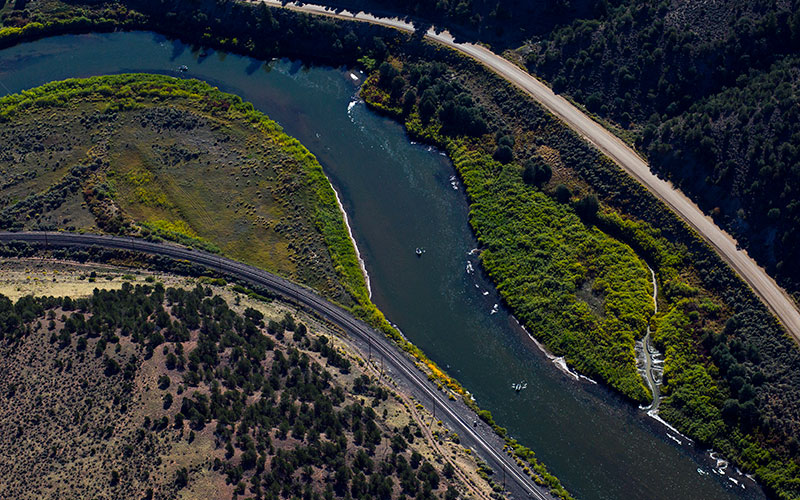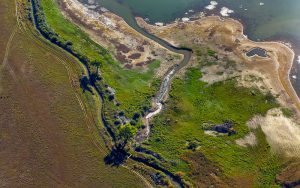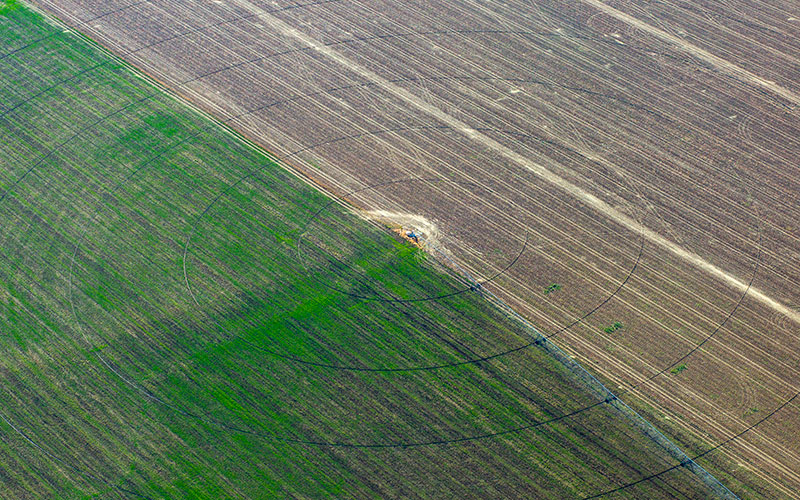
Legal uncertainty over the Colorado River is affecting which water rights are being included, and left off the 2020 abandonment list. (Photo by Nick Cote for KUNC/LightHawk)

Municipal water rights are subject to inclusion on the abandonment list, but show up in far fewer numbers than agricultural water rights. (Photo by Nick Cote for KUNC/LightHawk)
Use it or lose it.
That saying is at the heart of how access to water is managed in the western U.S. Laws that govern water in more arid states, such as Colorado, incentivize users to always take their full share from rivers and streams, or risk the state rescinding it. The threat comes in the form of a once-a-decade document that lists those users on the brink of losing their access to one of the region’s most precious resources.
It’s called the Decennial Abandonment List – and being included on it strikes fear and paranoia into rural pockets of the state, where farmers and ranchers depend on water for their livelihoods. Farmers trade tales of neighbors who’ve been mistakenly listed, with a notice sent to a wrong address, and who eventually see their water rights effectively canceled.
Abandonment horror stories are akin to urban – or in this case, rural – legend.
Western Colorado water lawyer Rob Pierce says there’s one thing his clients, mostly farmers and ranchers, are always asking him about.
“The whole concept of abandonment,” Pierce said. “It gets mentioned all the time.”
Pierce practices for the Grand Junction-based firm Dufford Waldeck, and he said interest in abandonment reaches its apex right before the state releases the list. Colorado’s initial abandonment list was scheduled for July 1, the first time it’s been updated since 2010. Preparations for this year’s list began in 2018.
By law, state regulators are required to compile the list every 10 years. It details all the water rights no longer being used to irrigate crops, flow through city plumbing systems or cool turbines in factories and power plants. If they’re determined to no longer be in use, they’re scrubbed from the record, and can’t be used again. Because the stakes are so high, Pierce said scuttlebutt about who’s on it and who’s not starts early.
“It does feel a little bit like the old West,” he said. “I mean, there aren’t many things these days where you can have a property right in something and lose it like this.”
The idea behind the abandonment list is rooted in Western water law. Ever since the 1800s, when the concept of prior appropriation became the dominant methodology to divvy up water in the region, Westerners have been able to petition for rights based on their ability to put it to “beneficial use.” Not using it? Then you can lose it.
But like many old adages in the West’s water lore, Pierce said, it’s more complicated than it sounds.
“I don’t want to call it the boogie man because that suggests that there’s not actually a threat,” Pierce said. “But it’s something that I think the threat looms larger maybe than it actually is in many people’s minds.”
Water attorney Kara Godbehere, of Longmont, Colorado-based firm Lyons Gaddis, agreed.
“It’s not as easy as ‘use it or lose it’ makes it sound I think,” Godbehere said. “That terminology is maybe a little inflammatory or misleading because it’s not as though without you realizing it, your water right would just slip out of your hands.”
It’s actually pretty difficult to lose it, Godbehere said. First, a user has to stop diverting the water for a long time. She points out abandonment lists come out once in a decade, and it sometimes takes an even longer period of 15 to 20 years to establish non-use. Users aren’t likely to put their right in jeopardy unless there’s a strong pattern of non-use, she said. And, even more importantly, she said, you have to intend to abandon it. It’s not an accident.
“It’s not as though it just sort of disappears one day and somebody is left wondering, where did my water go?” Godbehere said.
Rights can either be fully or partially abandoned as well. If a farmer switches to a more water-efficient crop, like replacing a field of alfalfa hay with hemp for example, the water consumed over time could be less. And the water right used to irrigate that field could end up being partially, not completely, abandoned.

A ditch spills water into a storage pond on Colorado’s Front Range. (Photo by Nick Cote for KUNC/LightHawk)
More than 2,700 individual water rights were initially listed as abandoned on the 2010 list. After going through a court process, where people who think they’ve been erroneously included have time to appeal, the list was whittled down to roughly 2,200 water rights that were officially declared abandoned, according to records from the Colorado Division of Water Resources. The vast majority of those rights were from farms and ranches, used to irrigate crops or pastureland. Agriculture uses about 80% of all available water in Colorado.
“The idea of abandonment is really to the general benefit of water users in the particular basin,” said Kevin Rein, the Colorado state engineer. He oversees the process of creating the list at the helm of the Division of Water Resources.
The abandonment list allows his department to clean up the books every now and then, and remove old rights from the record. Without abandonment, Rein said, a situation could arise where someone with old water rights, who hadn’t used them in a long time, all of a sudden starts using them again. That new use could upend how a whole water system functions, leaving some users short.
“So if you’re not using it, you should not be able to hold onto it, keep it for some other day if you don’t have a plan to use it,” Rein said. The beneficial use requirement also makes it difficult to speculate on water rights, and requires those who have access to water to use it, rather than sit on it and wait for it to accrue value.
This year’s list also reflects some ongoing uncertainty in the realm of Western water politics. Earlier this year, Rein sent a message to his division engineers, the state officials who compile the abandonment lists in their regions, telling them not to abandon rights that pre-date the 1929 Boulder Canyon Project Act, the piece of legislation that authorized the construction of Hoover Dam on the Colorado River.
Colorado is still uncertain what role abandonment might play in the hypothetical legal battle that could result from a violation of the Colorado River compact, which spells out a certain amount of water the states of Colorado, Wyoming, Utah and New Mexico are expected to send downriver to Arizona, Nevada, California and Mexico.
Those pre-1929 rights are called “present-perfected rights,” and likely aren’t subject to any sort of curtailment that would result from a compact call on the river. They’re some of the oldest, and most valuable, water rights in the entire Colorado River watershed.
But how those rights play into it is still unknown. Rein said after consulting with lawyers at the Colorado attorney general’s office, he instructed his division engineers not to include them. The same thing happened in 2010, so for more than 20 years, those pre-1929 rights haven’t been included on the list.

Agriculture accounts for about 80% of Colorado’s water use, and water rights on farms and ranches make up the majority of those declared abandoned by the state. (Photo by Nick Cote for KUNC/LightHawk)
How do those present-perfected rights benefit Colorado’s standing in a protracted legal battle over the management of the Colorado River?
“That’s where I need to just honestly tell you, I don’t know,” Rein said. “And I’m not embarrassed to say I don’t know.”
But beyond arcane legal thought experiments on the Colorado River, the “use it or lose it” concept, and the threat of abandonment, also give individual water users some perverse incentives.
“The most valuable thing that people have on a farm or ranch, is the water right,” said Jeni Arndt, a Democratic state representative from Fort Collins.
In general, the more water you have rights to, the more money it’s worth. The actual value can vary depending on drought conditions, and whether nearby development or other new demands for water are coming online. So if the volume is tied to a dollar amount, and a user can be paid big sums of money to transfer their right to a new use, why would anyone ever want to conserve it?
Arndt introduced a bill this year that would have allowed farmers, ranchers and other major water users to use their water more efficiently, through a state-approved conservation program, and avoid having their water rights listed as abandoned for a period of time.
“But it’s to help farmers and ranchers realize the value of their water right, without necessarily having to sell.”
Arndt initially put the limit at 20 years, then revised to five years, eventually pulling the bill altogether. Farm groups and others in the Colorado water community brought up concerns about it. She’s hoping to work on the idea this summer and bring it back during the 2021 legislative session.
“We need to design our laws and policies so that we can meet our water short future. And that’s a real deal,” Arndt said.
As Colorado and the West continue to dry out, she said something will have to give. And communities throughout the region might just have to challenge some of those foundational ideas in Western water law – like the abandonment list.
This story is part of ongoing coverage of the Colorado River, produced in partnership with KUNC in northern Colorado, with support from the Walton Family Foundation.